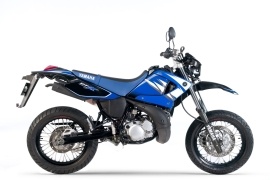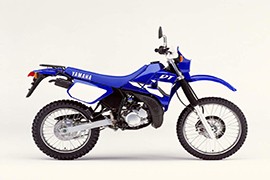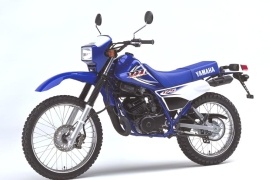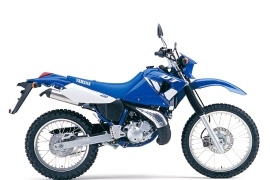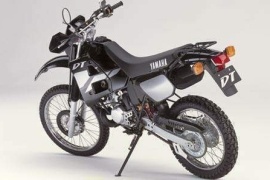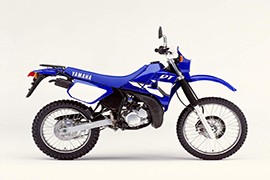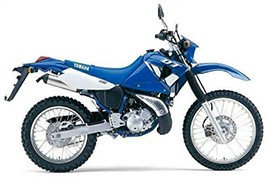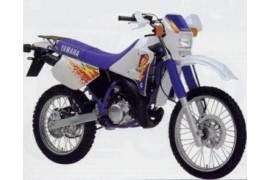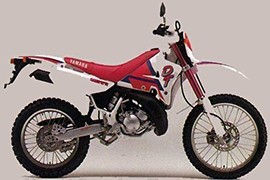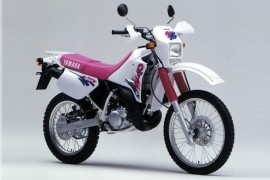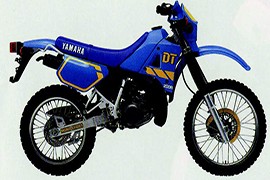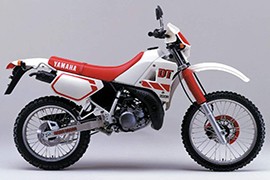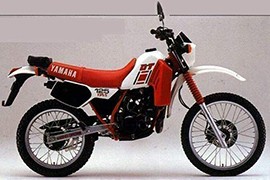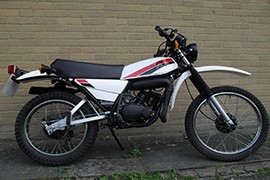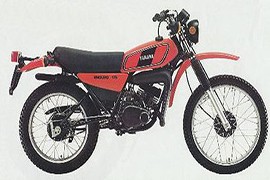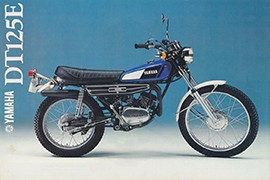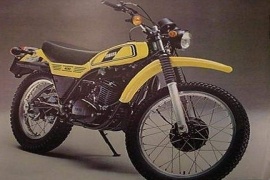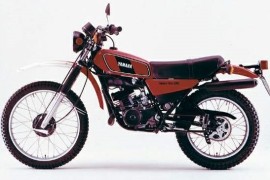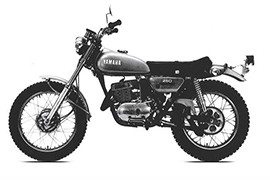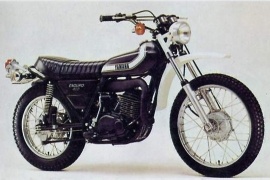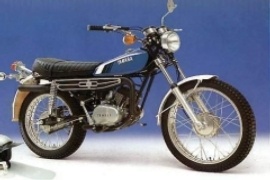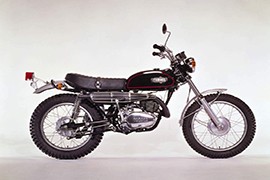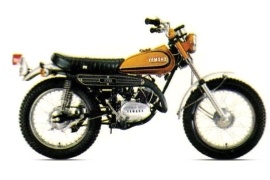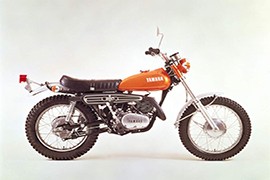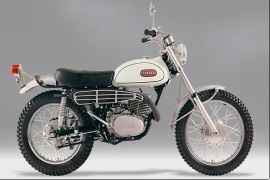YAMAHA DT Models/Series Timeline, Specifications & Photos
First production year: 1968
In 2004, the Japanese motorcycle manufacturer launched the Yamaha DT 125X, a motorcycle based on the earlier DT 125 version. The 125X model was more modern and more road-oriented due to its tires.
The Yamaha DT 125 debuted in 1974 as the DT 125A and continued production until 2008. The American market received the last DT 125H model in 1981. Over the years, the DT 125 has undergone numerous upgrades and modifications, almost every time, with a new suffix at the end of its name.
In the aesthetic department, the DT 125X had fitted standard features, such as wire-spoke wheels with road tires, an under-seat-mounted exhaust system, a one-piece dual seat with passenger grab handles, a high-mounted front plastic fender, and a rectangular headlight integrated into a small front cowl.
The bike was built around a semi-double-cradle steel frame with a 41 mm telescopic fork on the front that offered 120 mm of travel. The rear end was handled by a Mono-Cross shock absorber with 200 mm of travel, offering excellent handling capabilities.
As for the power figures, the 2004 Yamaha DT 125X had its heartbeat set by a 123cc two-stroke single-cylinder liquid-cooled engine managed by a Mikuni carburetor, boasting 15 hp with a peak force at 7,000 rpm and 16 Nm (12 lb-ft) torque at 7,000 rpm.
The Yamaha DT 125 was a dual-purpose motorcycle that effortlessly ran on paved and unpaved roads. The bike was first released in 1974 as the DT 125A and continued production until 2008. The DT 125H was the last model in the American market, which ended in 1981.
In 2001, the Japanese motorcycle manufacturer launched the Yamaha DT 125RE, an enduro motorcycle with the same technical, performance, and visual specifications as the previous model without any significant modifications.
The bike's appearance was characterized by standard features, such as a high-mounted front plastic fender, a square headlight, hand guards, a one-piece dual seat with pillion grab handles, a small luggage rack, an under-seat-mounted exhaust system, and lightweight wire-spoke wheels.
In the performance department, the 2001 Yamaha DT 125RE had installed a 123cc two-stroke single-cylinder liquid-cooled engine underneath its fuel tank, delivering an output power of 15 hp with maximum strength at 7,000 rpm and 16 Nm (12 lb-ft) torque at 7,000 rpm.
The bike retained the same suspension system as the previous model, including a 41 mm telescopic fork on the front with 170 mm of travel and a Mono-Cross shock absorber on the rear with 200 mm of travel.
As for the braking performance, the bike packed a 230 mm brake disc on the front end and a 220 mm disc on the rear. Both discs were engaged by hydraulic calipers and offered optimum stopping power.
These motorcycles were near indestructable and were among the best to come out of Japan.
The 2000 DT 230 is a complete package for a newcomer to motorcycling who has a dual-purpose. It’s comfortable, smooth, plush without being soggy, and very easy on the eye.
The Yamaha DT 125 was a dual-purpose enduro motorcycle that debuted in 1874 and continued production until 2008. The bike was first released in 1974 as the DT 125A and ran through 2008. It was last seen as the DT 125H in the American market in 1981.
In 2000, the Japanese motorcycle manufacturer launched the Yamaha DT 125R, which ran on both paved and unpaved roads. It came with the same package as the previous model without significant modifications.
As for the standard features, the bike packed a square headlight integrated into a small front cowl acting like a small wind deflector, a plastic front fender, a one-piece dual seat with passenger grab rails, a small luggage rack, a raised exhaust system, a side stand, and wire-spoke wheels with off-road tires.
Suspension-wise, the bike packed a 41 mm telescopic fork on the front with 170 mm of wheel travel and a Mono-Cross shock absorber on the rear with 200 mm of travel, offering excellent handling capabilities.
The braking performance was achieved by a 230 mm brake disc on the front and a 220 mm brake disc on the rear, both engaged by hydraulic calipers.
As for the power figures, the 2000 Yamaha DT 125R had its heartbeat set by a 123cc two-stroke single-cylinder liquid-cooled engine that delivered an output power of 15 hp at 7,000 rpm and 16 Nm (12 lb-ft) torque at 7,000 rpm.
In 1998, the Japanese motorcycle manufacturer launched the Yamaha DT 125RE, a dual-purpose enduro motorcycle that ran smoothly on paved roads and off-road trails. The bike debuted in 1974 as the DT 125A and continued production until 2008 with numerous modifications and upgrades.
Aesthetically, the 1998 DT 125RE was similar in design to previous models, packing standard features, such as a rectangular headlight integrated into a small front cowl, a high-mounted front fender, a one-piece dual seat with pillion grab rails, a small luggage rack, a raised exhaust system, and wire-spoke wheels with off-road tires.
Over its production period, the DT 125 received numerous modifications and upgrades, almost each receiving a new designation.
Suspension-wise, the bike packed a 41 mm telescopic fork on the front with 170 mm wheel travel and a Mono-Cross shock absorber on the rear with 200 mm of travel, providing excellent handling capabilities.
As for the braking power, the bike's wheels were fitted with a 230 mm disc on the front and a 220 mm disc on the rear, both coupled to hydraulic calipers.
In the performance department, the 1998 Yamaha DT 125RE had its soul brought to life by a 123cc two-stroke single-cylinder liquid-cooled engine managed by a Mikuni carburetor, delivering an output power of 15 hp with a peak force at 7,000 rpm and 16 Nm (12 lb-ft) torque at 7,000 rpm.
The DT 230 Lanza is designed for the Japanese market in that riders avoid models with a large chassis and has a debut in 1997. It has a 224cc two-stroke monocular engine equipped with a traction control system, a newly designed frame, front and rear suspensions that offer a good damping combination performance and ease of touching the foot, a digital panel with multifunctional tools. The DT 230 is a bicycle version that is equipped with an aluminum hinged arm and Yamaha computerized lubrication system that controls the amount of lubricating oil used by the engine.
In 1993, the Japanese motorcycle maker released the Yamaha DT 125R, a dual-purpose enduro motorcycle with the same package as the previous model without any modifications whatsoever.
The 1993 bike packed the exact technical, visual, and performance specifications as the previous model. Over its production period, the DT 125 received numerous restyles, upgrades, and modifications, enhancing its overall capabilities.
Visually, the bike was identical to the previous model, packing standard features, such as laced wheels, a square headlight up front, hand guards, a one-piece dual seat, a high-mounted exhaust system, and a high-mounted front fender.
The bike's suspension system comprised a telescopic fork on the front and a Mono-Cross shock absorber on the rear, providing excellent handling on both paved and unpaved roads.
As for the braking power, compared to earlier models, the 1993 DT 125R was fitted with a 230 mm brake disc on the front wheel and a 220 mm brake disc on the rear wheel, both tied to hydraulically operated calipers.
The 1993 Yamaha DT 125R had installed a 123cc two-stroke liquid-cooled one-cylinder engine underneath its fuel tank, boasting 14 hp with a peak force at 6,500 rpm and 15 Nm (11 lb-ft) torque at 6,500 rpm.
The engine's power was handled by a six-speed manual transmission with a wet multi-plate clutch and sent to the rear wheel through a final chain drive, reaching a maximum speed of 125 kph (78 mph).
Engineers developed this bike from the concept of dirt bike and street motorcycle. It was occasionally used for amateur enduro competitions because of its power, aggressiveness and ride ability.
The Yamaha DT 125 was a dual-purpose enduro motorcycle made by Yamaha in 1874, continuing production until 2008. The bike debuted in 1974 as the DT 125A and ran through 2008. It was last seen as the DT 125H in the American market in 1981.
Over its lifetime, the motorcycle received numerous upgrades and modifications, including a single shock absorber and a swingarm introduced in 1977. The maker called it Mono-Cross (MX for short).
Another significant modification was made in 1982, gaining a major restyle and a new liquid-cooled system, all under the DT 125LC designation. In 1984, the bike's electric system was upgraded to 12V, the Yamaha Power Valve System (YPVS) was added, the front drum unit was changed with a disc, and a rising rate rear suspension system was installed.
In 1987, the manufacturer introduced the DT 125R, featuring another restyle, among other changes. The most notable modification was the introduction of a rear brake disc.
In 1991, the Japanese motorcycle manufacturer launched the Yamaha DT 125R, a dual-purpose motorcycle fitted with standard features, such as a rectangular headlight, a high-mounted front fender, hand guards, a one-piece dual seat with passenger grab handles, a small luggage rack, a high-mounted exhaust system, and wire-spoke wheels.
As for the power figures, the 1991 Yamaha DT 125R had installed a 123cc two-stroke liquid-cooled single-cylinder engine, boasting 14 hp at 6,500 rpm and 15 Nm (11 lb-ft) torque at 6,500 rpm.
The 1990 Yamaha DT 200R model is a Enduro / offroad bike manufactured by Yamaha. In this version sold from year 1990, the dry weight is 108 Kg (238 lb) and it is equiped with a Single cylinder, two-stroke motor.
This was a street-legal trail model that retained the mechanisms, performance and image of Yamaha's competition motocrossers. Its liquid-cooled 2-stroke single-cylinder engine was outfitted with exclusive Yamaha 2-stroke technologies like YEIS to smooth out the intake pulse and YPVS with its variable valve to increase exhaust efficiency. The result was a high power output of 33 horsepower.
The Yamaha DT 125 was a dual-purpose enduro motorcycle manufactured by Yamaha from 1874 and continued production until 2008. The bike debuted in 1974 as the DT 125A and ran through 2008. It was last seen as the DT 125H in the American market in 1981.
In 1983, the Japanese motorcycle manufacturer released the Yamaha DT 125LC, which handled both paved and unpaved roads. A year earlier, in 1982, the bike received a significant restyle and a new liquid-cooled engine.
In the visual department, the bike packed standard features, such as a rectangular headlight integrated into a front cowl, a high-mounted front fender, a redesigned fuel tank, a one-piece double seat with a passenger grab handle, a skid plate, and wire-spoke wheels with off-road tires.
In the suspension department, the bike packed a telescopic fork on the front and a Mono-Cross (MX) suspension system on the rear, providing excellent handling weather on or off-road.
As on previous models, the braking power was achieved by a drum braking unit on both front and rear wheels, delivering optimum stopping performance.
As for the power figures, the 1983 Yamaha DT 125LC had its soul brought to life by a 123cc two-stroke single-cylinder liquid-cooled engine that delivered an output power of 14 hp with maximum strength at 6,500 rpm and 15 Nm (11 lb-ft) torque at 6,500 rpm.
In 1980, the Japanese motorcycle manufacturer launched the Yamaha DT 125MX, a dual-purpose motorcycle with a moto-crosser style, delivering the comfort and manoeuvrability of a first-class roadster.
The Yamaha DT 125 was an enduro motorcycle that debuted in 1974 as the DT 125A. The DT suffix indicated a two-stroke off-road-style design with features such as a raised exhaust system, a cross members handlebar, universal tires, and enough ground clearance.
In the visual department, the bike was fitted with standard features, such as a round headlight up front with two instrument gauges mounted on top, a high-mounted front fender, a one-piece dual seat, a side stand, and wire-spoke wheels with mixed tires.
The bike was built around a tubular semi-double-cradle steel frame with a telescopic fork on the front, delivering 160 mm of travel, and a Mono-Cross suspension system on the rear, providing 115 mm of travel.
The braking performance was still handled by a drum braking unit on both front and rear wheels, like on previous models, delivering optimum stopping power.
In the performance department, the 1980 Yamaha DT 125MX had installed a 123cc four-stroke air-cooled single-cylinder engine that delivered an output power of 14 hp with a peak force at 6,500 rpm and 15 Nm (11 lb-ft) torque at 6,000 rpm.
The power produced by the engine was transferred to a six-speed manual transmission with a wet multi-plate clutch, spinning the rear wheel through a final chain drive, reaching a top speed of 119 kph (74 mph).
The Yamaha DT 175 was the second last in a long line of enduro motorcycleas that can be traced back to the back to the CT-1.
The Yamaha DT 125 was an enduro motorcycle first released by Yamaha in 1974 under the DT 125A designation. The bike debuted in 1974 and continued production until 2008. The DT 125H was the last model dropped from production in the American market in 1981.
In 1978, the Japanese motorcycle manufacturer launched the Yamaha DT 125, a dual-purpose entry-level motorcycle with an electric start system that appealed to all users, whether on or off-road, at a simple touch of a button.
In the visual department, the 1978 motorcycle was identical to the previous model, wearing the same standard features, such as a one-piece dual seat, a round headlight up front, a Mono-Cross rear suspension system, a high-mounted exhaust system, and wire-spoke wheels.
The bike's suspension system comprised a telescopic fork on the front with 160 mm wheel travel and a Mono-Cross shock absorber on the rear with 115 mm travel, delivering optimum suspension performance and handling capabilities.
In the braking department, the bike's wheels were fitted with a drum braking unit both front and rear, delivering optimum stopping power.
As for power, the 1978 Yamaha DT 125E had its heartbeat set by a 123cc two-stroke air-cooled single-cylinder engine fed by a Mikuni carburetor, delivering 13 hp with maximum strength at 7,000 rpm and 14 Nm (10 lb-ft) torque at 6,500 rpm.
The latest Yamaha DT 400 has a new monoshock frame. The DT 400 has a performance capability close to that of the pure motocross machine.
The Yamaha DT 125 was a motorcycle manufactured by Yamaha from 1974 until 2008. The bike saw the first sunshine in 1974 and was named DT 125A. The last sunset was seen on American grounds in 1981 as the DT 125H.
Suppose anybody wonders what DT stands for, well. In that case, it indicates a two-stroke, off-road motorcycle with features such as a raised exhaust system, a cross-member handlebar, universal tires, and enough ground clearance for an off-road enduro motorcycle.
Over its lifetime, the bike received numerous modifications, including the introduction of a single shock absorber on the rear in 1977, named by the maker as a Mono-Cross system.
In 1977, the Japanese motorcycle manufacturer launched the Yamaha DT 125, an entry-level, road-legal, and off-road wordy motorcycle capable of running on paved roads and unpaved trails.
The bike was fitted with standard features, such as wire-spoke wheels, off-road tires, a single exhaust system mounted high on the left side, a one-piece dual seat, a high-mounted front fender, and a round headlight up front.
The bike's suspension system comprised a telescopic fork on the front and a new single Mono-Cross shock absorber on the rear, providing optimum handling capabilities.
As for the power figures, the 1977 Yamaha DT 125 had installed a 123cc two-stroke single-cylinder air-cooled engine underneath its small fuel tank, boasting only 13 hp with a peak force at 7,000 rpm and 10 Nm (7 lb-ft) torque at 6,500 rpm.
The DT's engine was your basic 250cc air-cooled two-stroke single that was dirt reliable plus dirt cheap to operate and maintain. Fed by a 26mm Mikuni carburetor and with 6.8:1 compression, the 246cc (15 seven ports on its "Torque Induction" two-stroke engines). Along with the standard intake, exhaust and transfer ports, Yamaha used an additional two transfer ports along with holes in the piston skirt. These ho would normally be covered by the skirt. This small detail resulted in a slight increase in power, and better throttle response than Yamaha's pre 1972 engines.
This new big-bore 400cc enduro. Go just about anywhere, do just about anything and do it with zip! The DT1 250 had grown up, first to 360 size, and now 400, and had become an extremely seductive machine.
The Yamaha DT 125 was an enduro motorcycle manufactured by Yamaha from 1974 until 2008. The bike was first released in 1974 as the DT 125A and was last seen in the American market as the DT 125H in 1981.
The DT designation indicated a two-stroke, off-road-styled motorcycle with a raised exhaust system, a cross-member handlebar, universal tires, and enough ground clearance for an off-road enduro motorcycle.
When first released, the bike packed a single-cylinder, two-stroke air-cooled engine, a cradle-style tubular steel frame, a traditional telescopic fork on the front, twin shocks on the rear, and drum braking units both front and rear.
Over its production period, the bike gained several upgrades and modifications, including the introduction of a single shock absorber on the rear in 1977, which the maker referred to as a Mono-Cross system.
Other modifications were represented by a significant restyle and a liquid-cooled engine in 1982, upgraded electronics and a brake disc on the front in 1984, and another restyle in 1987 alongside a rear brake disc.
In 1974, the Japanese motorcycle manufacturer launched the Yamaha DT 125, a motorcycle powered by a 123cc two-stroke single-cylinder liquid-cooled engine fed by a carburetor. The engine delivered an output power of 14 hp with a peak force at 7,500 rpm and 14 Nm (10 lb-ft) torque at 7,000 rpm.
The DT360A has a new frame longer and heavier than that of old enduro. This bike can go 10 to 15 24 Km (15 mph) faster than last year enduro with less rider effort.
The ideal size and weight, coupled with the right amount of usable power, is to be found in the DT175, it is the size of a 125 machine and yet produces power and torque akin to a 250.
The Yamaha DT 250, also known as the DT-2, was a dual-sports or enduro motorcycle made by Yamaha in 1971 as a successor to the Yamaha DT-1 and continued production until 1982. The bike was developed for both on-road and off-road use.
In 1971, the Japanese motorcycle maker released the Yamaha DT-2 250, a dual-sports motorcycle part of the DT series created by Yamaha in the 1960s when the American motorcycle market was down.
In the visual department, the bike was as simple as it gets, packing standard features, such as a small round headlight up front, a small fuel tank, a one-piece dual seat, side-mounted rear shocks, and wire-spoke wheels with off-road tires.
As for performance, the 1971 Yamaha DT-2 250 had its heartbeat set by a 246cc two-stroke single-cylinder liquid-cooled engine fed by a Mikuni carburetor, delivering an output power of 24 hp with a peak force at 7,000 rpm and 24 Nm (18 lb-ft) torque at 6,000 rpm.
The engine was tied to a five-speed manual transmission with a wet multi-plate clutch, sending the power to the rear wheel through a final chain drive.
The bike was manufactured around a duplex cradle frame with a telescopic fork on the front and dual side-mounted shock absorbers on the rear, providing optimum suspension performance.
As for the braking power, the bike packed a drum braking unit both front and rear, offering optimum stopping power.
The Yamaha DT was a series of motorcycles and mopeds manufactured by Yamaha from 1968 to 1985. The DT series was created in the 1960s when the American motorcycle market was down and comprised models with engine displacements ranging between 40 to 400cc.
In 1968, the Japanese motorcycle manufacturer launched the Yamaha DT-1, their first model, which had great success and quickly sold through its 12,000 production run. The DT-1 model defined a new market for motorcycles.
It was a dual-sports motorcycle developed to run on off-road trails, with its block-pattern tires, decent ground clearance, and cutting-edge design for its period. It was driven by a 250cc one-cylinder engine based on a motocross design.
The bike was built around a steel frame with a telescopic fork on the front and dual side-mounted shock absorbers on the rear, delivering excellent suspension performance and handling capabilities.
The braking performance was handled by a front and rear drum braking unit, providing optimum stopping power.
In the visual department, the bike packed standard features, such as a small, round headlight on the front, a single seat, a high-mounted exhaust system, steel fenders, and lightweight wire-spoke wheels with off-road tires.
As for the power figures, the 1968 Yamaha DT-1 had installed a 250cc two-stroke air-cooled single-cylinder engine underneath its small fuel tank, delivering 21 hp at 6,000 rpm.
